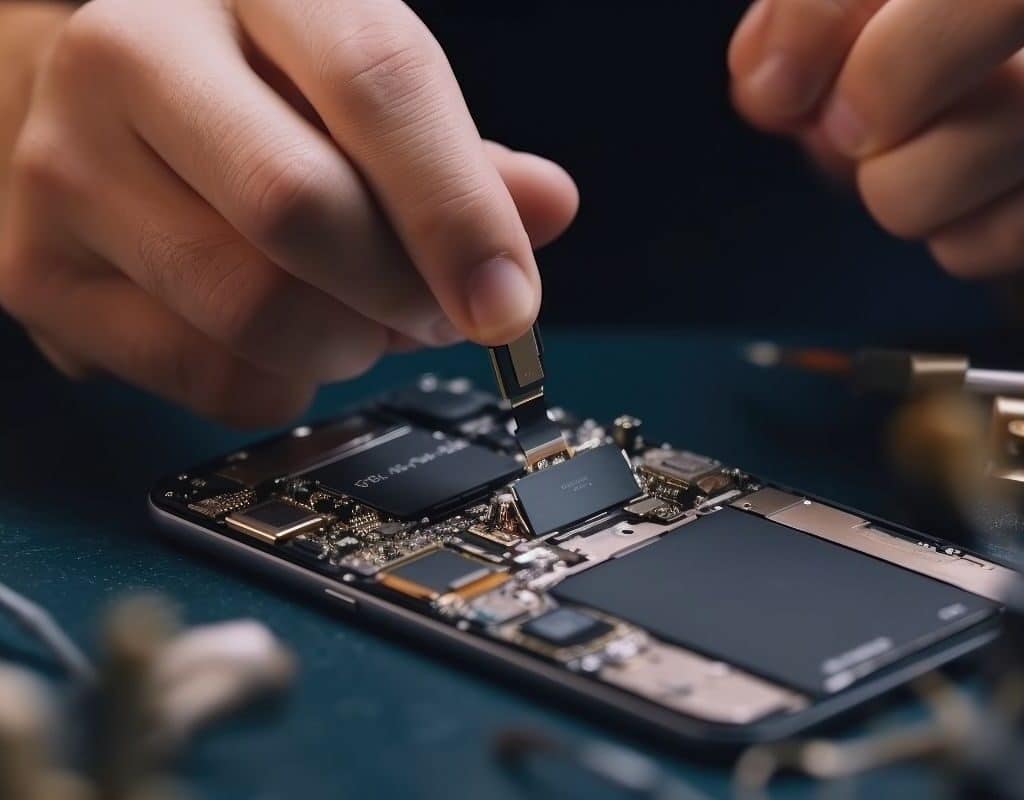Is your iPhone not charging? It might just be a dirty or faulty charging port—and the fix could be easier than you think. Before you rush to the Apple Store or spend money on a new charger, take a moment to check the one part most people overlook: the charging port. A bit of lint, dust, or a loose connection could be the reason your iPhone isn’t powering up.
In this DIY troubleshooting guide, you’ll learn safe, step-by-step methods to clean and how to fix an iPhone charging port—without damaging your phone or spending a dime. Stick around and you’ll walk away with simple, effective solutions that just might save your day (and your device).
Why Your iPhone Charging Port May Not Be Working
If your iPhone won’t charge, a dirty or damaged charging port is often the culprit. Learn the common reasons behind iPhone charging port issues including dust buildup, loose connections, or hardware failure and how to spot them early. Understanding these signs can help you fix your iPhone charging port faster and cheaper. Here are the following reasons your iPhone’s charging port may not be working:
1. Physical Issues
- Damage: The charging port itself might be physically damaged, loose, or misaligned due to rough handling, drops, or awkward cable insertion.
- Debris: Dust, lint, or other particles can accumulate in the port, preventing proper contact between the cable and the phone’s charging pins.
- Cable or Adapter Problems: A damaged or frayed charging cable, or a non-Apple-certified or defective adapter, can also prevent charging.
- Water Damage: If your phone has been exposed to water or moisture, it can damage the charging port or internal components.
2. Software Issues
- Software Glitches: Sometimes, a minor iOS bug or glitch can prevent the phone from recognizing that it’s plugged in.
- Battery Health: If the battery health percentage is low (below 80%), Apple recommends replacing the battery, which might also address charging issues.
- Software Update: Outdated software can sometimes interfere with charging, so updating to the latest iOS version can help.
3. Other Potential Issues
- Loose Connection: A loose connection between the cable and the charging port can also cause intermittent or non-existent charging.
- External Factors: Incorrect use of the charging cable or charger, or using a non-Apple-certified or defective adapter, can also prevent charging.
Signs of Port Issues vs. Cable or Battery Problems
Not sure if it’s your iPhone charging port, cable, or battery causing the problem? This section helps you spot the difference with clear signs and symptoms. Learn how to diagnose iPhone charging issues fast—so you know whether to clean the port, replace the cable, or check the battery. Let’s breakdown the issues in details:
Charging Port Issues
Your iPhone charging port is more delicate than you might think. Here are some signs it’s the problem:
- Loose or Wobbly Connection: If the cable wiggles or falls out easily, the port might be worn or damaged.
- Inconsistent Charging: The charging icon keeps appearing and disappearing this usually means the port isn’t making a solid connection.
- Slow Charging: Even with a working cable, your iPhone charges slowly? The port could be dirty or partially blocked.
- No Charging at All: If there’s no response when you plug it in, the port may be faulty or obstructed.
- Debris in the Port: Lint, dust, or small particles can block proper contact between your charger and phone.
- Overheating While Charging: If your iPhone or charger gets unusually hot, it could signal port resistance or internal damage.
- Visible Damage: Cracked plastic, bent pins, or other signs of wear on the port may mean it needs replacement.
Cable Issues
Sometimes, it’s not the port—it’s the cable. Look for these signs:
- Visible Damage: Frayed wires or bent connectors mean the cable is past its prime.
- Intermittent Charging: The cable only works when you bend it a certain way? That’s a red flag.
- No Charging Response: If your phone doesn’t react at all, try a known-good cable to test it.
- Slow Data Transfer: For data cables, slow syncing or transfer delays can point to internal wire damage.
Battery Problems
In some cases, the battery—not the port or cable—is the reason your iPhone isn’t charging properly. Watch out for:
- Sluggish Charging: The battery takes forever to fill, even when using a fast charger.
- iPhone Won’t Power On: If the phone doesn’t turn on at all, the battery might be drained or dead.
- Clicking or Glitching on Startup: Electrical clicking sounds or glitchy screens may indicate a deeper power issue.
- Battery Warning Light or Alerts: A battery-related error message may pop up on your screen.
- Swollen Battery Case: A bulging or bloated phone casing can be a serious safety issue—stop using the phone immediately.
What You’ll Need Before You Start Fixing
Before starting any fix, you’ll need the right tools and a clear plan. Having basic tools like a screwdriver, pliers, and a hammer can be helpful for many simple repairs. You may also need specific tools depending on the task, like a brush for painting or a wrench for plumbing.
It’s also wise to have safety gear like gloves, safety glasses, and a dust mask, especially for electrical projects or those involving hazardous materials. Finally, it’s helpful to research the issue, watch tutorials, or consult with experts if you’re unsure about a repair. Here’s a more detailed breakdown:
- Basic toolset: A screwdriver set, pliers, hammer, and a utility knife are a good starting point for many repairs.
- Specific tools: Depending on the repair, you might need a wrench, measuring tape, level, saw, or other tools specific to the project.
- Safety Gear: Gloves, safety glasses, a dust mask, and appropriate clothing can protect you from hazards.
- Specific materials: You’ll need the necessary materials, like nails, screws, paint, or replacement parts, depending on the repair.
- Safety: Make sure you’re using the correct materials for the job and that they are safe for your project.

Step-by-Step Guide on How to Fix An iPhone Charging Port
Need a simple, effective way to clean and restore your charging port? This step-by-step guide on how to fix an iPhone charging port walks you through each step using safe, easy methods to help your iPhone charge properly again—no tech skills required. Here are the steps to fixing an iPhone charging port:
Step 1: Power Off Your iPhone
Before doing anything, turn off your iPhone completely. This prevents short circuits and protects internal components while you clean the charging port safely.
Step 2: Inspect the Port With a Flashlight
Shine a light into your iPhone charging port. Look for lint, dust, or signs of damage that could be blocking the connection between your charger and the phone.
Step 3: Use a Toothpick or Brush to Remove Debris
Carefully clean out the port using a wooden toothpick or soft brush. Gently scrape the edges to remove any dirt or debris without pressing too deep into the port.
Step 4: Use Compressed Air (Optional)
If available, use compressed air to blow short bursts into the port. This helps clear out loose particles. Always avoid using liquids or spraying too close to the phone.
Step 5: Plug in Charger to Test It
Reconnect your iPhone to the charger and see if it powers up. If it doesn’t charge, try another cable or read on for additional troubleshooting tips and repair options.
When to Seek Professional Repair Help
Sometimes, cleaning your iPhone charging port isn’t enough. If your charger still doesn’t fit snugly, the port feels loose, or your iPhone won’t respond even with a known good cable, the issue may go beyond debris. Visible damage like bent pins or cracks inside the port are clear signs that you need a repair—not just a quick clean.
In these cases, it’s best to seek help from professionals like Techy Company. Whether you’re covered under AppleCare+ or exploring third-party repair options, getting an expert to inspect your device ensures it’s handled safely. Water damage, for instance, can cause corrosion inside the port that isn’t visible at first but leads to long-term issues. For newer models with Lightning or USB-C ports, replacement may require specialized tools and parts.
If you’re unsure where to start, check out our full range of iPhone Repair Services or go straight to Charging Port Replacement Services. You can also Book a Repair Appointment online for fast, same-day service.
Preventive Tips to Keep Your Charging Port Clean
Keeping your iPhone’s charging port clean can save you from future charging issues and expensive repairs. With a few simple habits, you can prevent dust, lint, and wear from causing connection problems. Here’s how to protect your iPhone and keep it charging smoothly every time. Here are 5 easy tips to keep your charging port clean:
- Use a dust plug – These small accessories block dust and debris from entering your charging port when not in use.
- Avoid lint-heavy places – Keep your phone out of pockets, bedsheets, and bags filled with fabric particles.
- Don’t use your phone while charging – Especially in bed or on soft surfaces, as movement can push lint into the port.
- Inspect your charging cable regularly – Frayed or bent connectors can wear down the port over time.
- Clean monthly with a soft brush – A quick sweep once a month can prevent buildup and ensure a solid connection.
The Bottom Line
Fixing an iPhone charging port may seem tricky, but with the right steps, it’s often a quick and simple DIY task. From removing lint and debris to checking your cable and port for damage, you now know exactly how to fix an iPhone charging port safely at home.
If cleaning doesn’t solve the issue, don’t hesitate to get expert help—charging problems can worsen over time if left unchecked. Whether it’s a minor fix or a full port replacement, acting early can save your device and your wallet. Need professional assistance? Book trusted repair services today and get your iPhone back to full power in no time.
FAQs – iPhone Charging Port Fixes
The cost to fix an iPhone charging port typically ranges from $50 to $100 at third-party repair shops. Apple may charge more, especially if you’re out of warranty. Check with local iPhone repair services for accurate pricing.
If your iPhone is under warranty or covered by AppleCare+, Apple might repair or replace the charging port at no cost. However, accidental damage or out-of-warranty devices usually require a fee. Confirm eligibility before visiting an Apple Store.
If your iPhone charges only at certain angles or the cable feels loose, it’s likely a port issue. If the phone powers off quickly or heats up, the battery might be the culprit. Try different cables and observe behavior.
A dirty or damaged charging port, faulty cable, or internal hardware failure can prevent charging. Start by cleaning the port and using a known-good charger. If the problem persists, it’s best to consult a charging port replacement service.
Yes, cleaning your iPhone charging port at home is safe if done carefully. Use a wooden toothpick or soft brush, never metal or liquids. Follow a step-by-step guide on how to fix an iPhone charging port to avoid damage.


Add a Comment